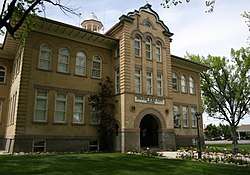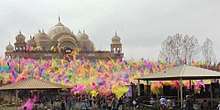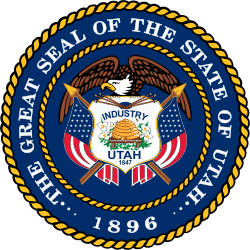Spanish Fork, Utah
Spanish Fork is a city in Utah County, Utah, United States.[1] It is part of the Provo–Orem Metropolitan Statistical Area. The population was 40,913 as of a 2019 estimate.[5] Spanish Fork, Utah is the 20th largest city in Utah based on official 2017 estimates from the US Census Bureau.[6]
Spanish Fork, Utah | |
|---|---|
 Spanish Fork city offices | |
| Nickname(s): Pride and Progress | |
 Location in Utah County and the state of Utah | |
| Coordinates: 40°6′54″N 111°39′18″W[1] | |
| Country | United States |
| State | Utah |
| County | Utah |
| Settled | 1851 |
| Incorporated | January 17, 1855 |
| Named for | Spanish Fork|Spanish Fork (river) |
| Area | |
| • Total | 16.21 sq mi (41.98 km2) |
| • Land | 16.21 sq mi (41.98 km2) |
| • Water | 0.00 sq mi (0.00 km2) |
| Elevation | 4,577 ft (1,395 m) |
| Population (2010) | |
| • Total | 34,691 |
| • Estimate (2019)[3] | 40,913 |
| • Density | 2,523.94/sq mi (974.48/km2) |
| Time zone | UTC−7 (Mountain (MST)) |
| • Summer (DST) | UTC−6 (MDT) |
| ZIP code | 84660 |
| Area code(s) | 385, 801 |
| FIPS code | 49-71290[4] |
| Website | www.spanishfork.org |
Spanish Fork lies in the Utah Valley, with the Wasatch Range to the east and Utah Lake to the northwest. I-15 passes the northwest side of the city. Payson is approximately six miles to the southwest, Springville lies about four miles to the northeast, and Salem is approximately 4.5 miles to the south.[7][8]
History
Spanish Fork was settled in 1851 by members of The Church of Jesus Christ of Latter-day Saints as part of the Mormon Pioneers' settlement of Utah Territory. Its name derives from a visit to the area by two Franciscan friars from Spain, Silvestre Vélez de Escalante and Francisco Atanasio Domínguez in 1776, who followed the stream down Spanish Fork canyon with the objective of opening a new trail from Santa Fe, New Mexico, to the Spanish missions in California, along a route later followed by fur trappers. They described the area inhabited by Native Americans as having "spreading meadows, where there is sufficient irrigable land for two good settlements. Over and above these finest of advantages, it has plenty of firewood and timber in the adjacent sierra which surrounds its many sheltered spots, waters, and pasturages, for raising cattle and sheep and horses."
In 1851, some settlers led by William Pace set up scattered farms in the Spanish Fork bottom lands and called the area the Upper Settlement.[9] However, a larger group congregated at what became known as the Lower Settlement just over a mile northwest of the present center of Spanish Fork along the Spanish Fork river. In December 1851, Stephen Markham, who was severely wounded outside Carthage Jail in Carthage, Illinois while attempting to defend Joseph Smith and other church leaders from a mob in 1844, became the president of the first church congregation (branch) at the Lower Settlement.[9]
In 1852, Latter-day Saints founded a settlement called Palmyra west of the historic center of Spanish Fork. George A. Smith supervised the laying out of a townsite, including a temple square in that year.[10] A fort and a school were built at the Palmyra site in 1852.[11] With the onset of the Walker War in 1853, most of the farmers in the region who were not yet in the Palmyra fort moved in.[12] Some of the people did not like this site and so moved to a different site at the mouth of Spanish Fork Canyon, where they built a structure they called "Fort St. Luke".[13] Also in 1854 there was a fort founded approximately 2 miles (3.2 km) south of the center of Spanish Fork that later was known as the "Old Fort".[9]
Between 1855 and 1860, the arrival of pioneers from Iceland made Spanish Fork the first permanent Icelandic settlement in the United States.[14] The city also lent its name to the 1865 Treaty of Spanish Fork, where the Utes were forced by an Executive Order of President Abraham Lincoln to relocate to the Uintah Basin.
Government
Spanish Fork has a city manager type of government. Seth Perrins is the current city manager, and Tyler Jacobson is the assistant city manager.[15]
The current mayor, Steve Leifson, was elected in the November 5, 2013 general election.[16] The members of the city council are: Chad Argyle, Stacy Beck, Brandon Gordon, Mike Mendenhall, and Keir Scoubes.[17][18]
Events

Spanish Fork City hosts five large-scale events each year: Fiesta Days, Icelandic Days, the Harvest Moon Hurrah, the Festival of Lights, and the Festival of Colors.
Icelandic Days
The Icelandic Association of Utah was founded in 1897 and hosts Iceland Days every year. The association picked June because Icelandic Independence Day, or National Day, is June 17.
Spanish Fork was the first Icelandic settlement in the United States, after Icelanders who joined the Church of Jesus Christ were expelled from that country, according to association spokesman Glenn Grossman. Although other nationalities helped found the town, under colonizer Brigham Young, Icelanders kept their identity and celebrate it with their culture every year during the three-day event.
Harvest Moon Hurrah
The Harvest Moon Hurrah is sponsored by the Spanish Fork Arts Council and takes place on a Saturday in September closest to the date of the full moon. Activities include children's crafts and activities, a giant paint-it-yourself mural, storyteller, old-fashioned family photos, caricature artist, clown and balloon animals, hay rides with live bluegrass band, and live entertainment. The 2009 Hurrah was headlined by Peter Breinholt, a local musician.[19]
Fiesta Days
Each year Spanish Fork hosts the "Fiesta Days". The event is held every July, and is centered around the Pioneer Day Celebration. There are a number of entertainment events, including a rodeo, craft fair, parade, duck race, and a fireworks show on the 24th.
Festival of Colors
The Sri Sri Radha Krishna Temple (erected by Christopher Warden, an International Society for Krishna Consciousness follower[20]) celebrates Holi and is known for the Festival of Colors where thousands of people gather from all over the country.[21]
Demographics and economy
| Historical population | |||
|---|---|---|---|
| Census | Pop. | %± | |
| 1860 | 773 | — | |
| 1870 | 1,450 | 87.6% | |
| 1880 | 2,304 | 58.9% | |
| 1890 | 2,686 | 16.6% | |
| 1900 | 3,327 | 23.9% | |
| 1910 | 3,751 | 12.7% | |
| 1920 | 4,035 | 7.6% | |
| 1930 | 3,727 | −7.6% | |
| 1940 | 4,167 | 11.8% | |
| 1950 | 5,230 | 25.5% | |
| 1960 | 6,472 | 23.7% | |
| 1970 | 7,284 | 12.5% | |
| 1980 | 9,825 | 34.9% | |
| 1990 | 11,272 | 14.7% | |
| 2000 | 20,246 | 79.6% | |
| 2010 | 34,691 | 71.3% | |
| Est. 2019 | 40,913 | [3] | 17.9% |
| U.S. Decennial Census[22] | |||
As of the 2010 census, there were 34,691 people, 9,069 households, and 7,885 families residing in the city. The population density was 2,252.7 people per square mile (871.6/km²). There were 9,440 housing units, at an average density of 613.0 per square mile (237.2/km²). The racial makeup of the city was 90.9% White, 0.4% African American, 0.5% Native American, 0.6% Asian, 0.7% Pacific Islander, 4.4% some other race, and 2.5% from two or more races. Hispanic or Latino of any race were 10.6% of the population.[23] As for ages, the population was quite young with 40.9% being under the age of 18, 53.6% aged 18–64 and 5.5% over the age of 65.[24]
At the 2000 census, the median income for a household in the city was $62,805, and the median income for a family was $64,909. The per capita income for the city was $17,162. About 4.3% of families and 6.2% of the population were below the poverty line.
Mountain Country Foods is currently Spanish Fork's largest private employer with 350 employees. Eight other businesses employ one hundred or more workers: SAPA, Klune Industries, Longview Fibre, Nature's Sunshine, Rocky Mountain Composites, J.C. Penney, Western Wats, and Provo Craft.[25]
Spanish Fork has a predominantly LDS population. There are seventy-four LDS wards in nine stakes in the southern Utah Valley and a temple, the Payson Utah Temple, which opened in June 2015. The majority of residents are Mormons just like all of Utah County. [26]
There are other churches in town: the Presbyterian Church established a church and mission day school in 1882. The school functioned until the state school system was inaugurated in the early part of the twentieth century. Today there are nine public elementary schools, two intermediate, and two high schools of the Nebo School District.[27]
A Lutheran church, established by immigrants from Iceland, was built on the east bench of Spanish Fork.[28] There is also the Faith Baptist Church, a Baptist congregation.[29]
A Roman Catholic church serves the Catholics of southern Utah Valley; many happen to be of Italian descent (see Utah Italians), Hispanics, Filipino Americans, and some Greek Catholics from the Balkans.[30]
ISKCON, the international society of Krishna Consciousness, have built a temple in Spanish Fork, run by Caru Das, the temple priest. Indian Americans form a small but noticeable community in the Spanish Fork-Provo area (especially in the neighboring town of Springville).[31]
In Utah Valley's historical settlement by immigrants, Scandinavians (most notably Icelanders); as well as Swiss people; Spanish Americans, Hispanics or Latinos; English Americans, Irish Americans and Scottish Americans are prevalent ethnocultural groups in Spanish Fork, and the nearby towns of Salem and Payson.[32]
Schools
In 1862, Spanish Fork built its first school house. That one room edifice served the city's educational needs for nearly 50 years. In 1910, Spanish Fork built the Thurber School on Main Street. Although it's not used for daily K-12 classes anymore, it still functions as a city office building.[33] Today, Spanish Fork is served by the Nebo School District. Public schools in this district within Spanish Fork include the following:
- Spanish Fork High School
- Maple Mountain High School
- Landmark High School (alternative school)
- Old Fort Junior High School
- Diamond Fork Junior High School (formerly known as Spanish Fork Middle School)
- Brockbank Elementary
- Canyon Elementary
- Larsen Elementary
- Park Elementary
- Rees Elementary
- Riverview Elementary School
- East Meadows Elementary
- Sierra Bonita Elementary
- Maple Ridge Elementary
In addition, there is a private girls school, the New Haven School, and a K-12 charter school, the American Leadership Academy.
Alternative energy
In September 2008, the Spanish Fork Wind Project was completed.[34] This project, a 9-turbine wind energy project, can produce up to 18.9 megawatts at full production, and the nine turbines can power up to 6,000 typical homes.[35][36] It is a utility-scale wind farm producing electricity from wind power.[37][38]
Notable people
- Stephen M. Studdert, Advisor to U.S. Presidents George Bush, Ronald Reagan, and Gerald Ford
- Gail Halvorsen, American candy bomber
- D. Elden Beck, educator
- Kate B. Carter, Utah pioneer historian
- Zebedee Coltrin, Utah pioneer
- Lucky Blue Smith, male model
- Kaycee Feild, four time PRCA world Champion Bareback rider.
- Isaac Asiata, American Football Player.
- Scott Brumfield, American Football Player.
- Hefa Leone Tuita, Dancer
See also
- List of cities and towns in Utah
References
- "2019 U.S. Gazetteer Files". United States Census Bureau. Retrieved August 7, 2020.
- "Population and Housing Unit Estimates". United States Census Bureau. May 24, 2020. Retrieved May 27, 2020.
- "U.S. Census website". United States Census Bureau. Retrieved 2008-01-31.
- "U.S. Census Bureau QuickFacts: Spanish Fork city, Utah". Census Bureau QuickFacts. Retrieved 2018-11-30.
- http://worldpopulationreview.com/us-cities/spanish-fork-ut-population/
- Utah Atlas & Gazetteer, DeLorme, 9th ed., 2014, p.25 ISBN 9780899332550
- https://www.distance-cities.com/distance-salem-ut-to-spanish-fork-ut
- Jenson. Encyclopedic History. p. 823
- Jenson, Andrew. Encyclopedic History of The Church of Jesus Christ of Latter-day Saints. (Salt Lake City: Deseret Book, 1941) p. 631-632
- Jenson. Encyclopedic History. p. 824
- Jenson. Encyclopedic History. p. 631
- Jenson. Encyclopedic History. p. 256-257
- Thorstina Jackson, "Icelandic Communities in America: Cultural Backgrounds and Early Settlements," 681.
- Spanish Fork City Manager
- Spanish Fork 2013 General Election Results
- Spanish Fork Mayor and City Council
- General Election Results
- Harvest Moon Hurrah
- http://www.utahkrishnas.org/utah-krishna-pioneers-2/
- http://www.utahkrishnas.org/festival-colors/
- "Census of Population and Housing". Census.gov. Retrieved June 4, 2015.
- "Profile of General Population and Housing Characteristics: 2010 Demographic Profile Data (DP-1): Spanish Fork city, Utah". United States Census Bureau. Retrieved March 8, 2012.
- "Spanish Fork (Spanish Fork City), Utah — Overview". United States Census Bureau, Moonshadow Mobile CensusViewer. Retrieved November 30, 2018.
- Spanish Fork City Economic Development
- The Church of Jesus Christ of Latter-day Saints Church Temples
- http://www.nebo.edu/
- Peach, Mary (1994), "Lutheran in Utah", in Powell, Allan Kent (ed.), Utah History Encyclopedia, Salt Lake City, Utah: The University of Utah Press, ISBN 0874804256, OCLC 30473917
- http://www.usachurches.org/church/faith-baptist-church.htm
- Mooney, Bernice M. (1994), "The Catholic Church in Utah", in Powell, Allan Kent (ed.), Utah History Encyclopedia, Salt Lake City, Utah: The University of Utah Press, ISBN 0874804256, OCLC 30473917
- http://iskcon.org/
- http://www.citytowninfo.com/places/utah/spanish-fork
- "About the City". Spanish Fork City. Retrieved 18 May 2012.
- Spanish Fork Wind Project
- Matthew Rich (October 6th, 2008) Spanish Fork wind farm brings alternative energy BYU NewsNet. Retrieved on 2009-04-08.
- Deseret News (September 6th, 2008)
- http://www.resilience.org/stories/2011-05-13/harvesting-utah’s-urban-winds
- http://www.ksl.com/?sid=4190348
External links
| Wikimedia Commons has media related to Spanish Fork, Utah. |
| Wikivoyage has a travel guide for Spanish Fork, Utah. |

